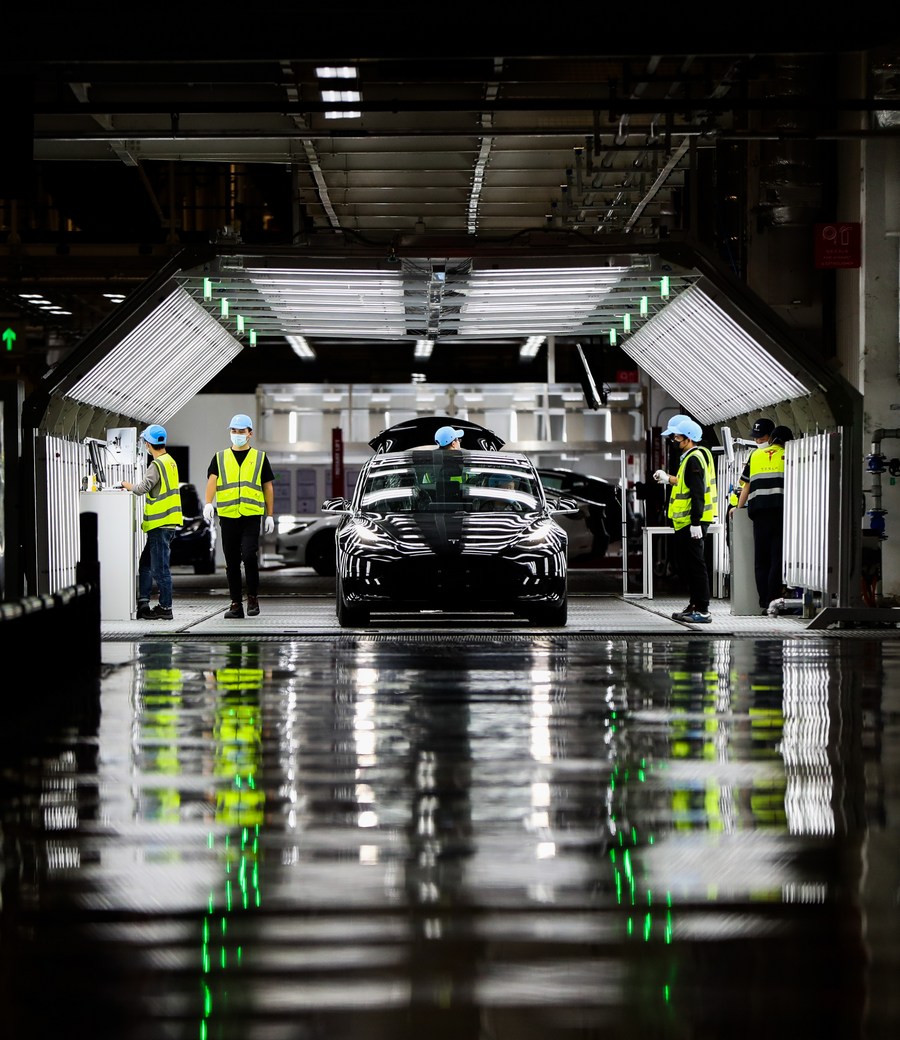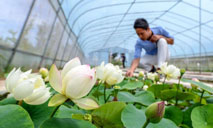China's largest city cluster accelerates high-quality integration
-- As a national strategy, the integrated development of the Yangtze River Delta, also the country's largest city cluster, has been accelerating.
-- "The more efficient transport connectivity in the Yangtze River Delta has facilitated the flow of capital, talent, resources and technologies, making it easier for joint scientific research and better allocation of the industry chain," said Chen Wen, a researcher with the Chinese Academy of Sciences.
-- At a high-level forum on the region's integrated development held in Wuxi on Thursday, authorities launched four regional industry chain alliances for the sectors of integrated circuit, biomedicine, new energy vehicles and artificial intelligence.
NANJING, May 27 (Xinhua) -- At 6:50 a.m., Liu Xiaochen unhurriedly boards a high-speed train for Shanghai, traveling more than 60 km to start his day of work in the metropolitan city in less than an hour.
"The high-speed trains are fast and on time, and I also do not need to worry about traffic congestion," said Liu, who lives in the city of Kunshan in Jiangsu Province that borders Shanghai.
For many people like Liu, such a daily commute is common nowadays, thanks to the fast-paced regional integration of the Yangtze River Delta which encompasses Shanghai and the provinces of Jiangsu, Zhejiang and Anhui.
The delta region, roughly the size of Germany, is one of China's most economically active, open and innovative regions, contributing to about one-fourth of the national gross domestic product. As a national strategy, the integrated development of the delta region, also the country's largest city cluster, has been accelerating.
"The more efficient transport connectivity in the Yangtze River Delta has facilitated the flow of capital, talent, resources and technologies, making it easier for joint scientific research and better allocation of the industry chain," said Chen Wen, a researcher with the Chinese Academy of Sciences.
STRONGER CONNECTIONS
Improved connectivity within the Yangtze River Delta, like the mushrooming high-speed railways and densely constructed expressways, has made the 358,000-square-km expanse one of the most populated and urbanized city clusters in China.

Aerial photo taken on Jan. 19, 2021 shows a bullet train running in Nanjing, capital of east China's Jiangsu Province. (Photo by Su Yang/Xinhua)
With the construction of 11 new railway projects kicking off this year, the delta region is expected to have 17,000 km of rail lines in service by 2025, including 9,500 km of high-speed railway, according to the China Railway Shanghai Group Co., Ltd.
"My wife and I live in Jiangsu's Taicang, but our daughter has settled down in Shanghai. The absence of shortcuts used to be a nuisance for family reunions," said Wu Qiping, a villager at Taicang's Ludu village, which borders Shanghai's Jiading District but was split by a river.
In June 2020, a 1.8-km-long highway with a bridge was built to directly link the village with Jiading District, shortening the travel time between the two places from over half an hour to a minimum of three minutes.
"The new road offers great convenience to around 7,000 villagers like Lu, as they can visit relatives, pursue jobs and go shopping in Shanghai more easily," said Li Ye, Party chief of Ludu village.
The convenience came after authorities in the region moved to build new roads to link the dead-end inter-provincial highways to accelerate regional integration.
The power networks in the region are also accelerating integration. Construction of a 385-meter-tall power transmission tower is underway in Jiangsu's Jiangyin City, which is part of a 500-kV power transmission project that will cross the Yangtze River to supply clean energy to the more developed cities of the delta region.
"The southern part of Jiangsu consumes two-thirds of the energy of the province yet lacks power resources, but the northern part is abundant in renewable energy resources," said Wang Weiyuan, a staff worker from State Grid's Jiangsu branch.

Aerial photo taken on June 23, 2018 shows the Xinyuan photovoltaic (PV) power station built on the top of agricultural greenhouses in Tangji Township of Lianshui County, east China's Jiangsu Province. (Xinhua/Li Yuze)
"The project will help better connect the power networks in the Yangtze River Delta region, helping achieve energy sharing among cities and effectively promoting power integration in the region," Wang added.
INDUSTRIAL SYNERGY
At the national-level pilot zone of Internet of Vehicles (IoV) in Jiangsu's Wuxi City, scenes of self-adjusted traffic lights to reduce congestion and unmanned car parking are giving a glimpse of the future smart traffic industry.
As a highland of the Internet of Things (IoT) industry in China, Wuxi is home to more than 3,000 IoT companies, and the city is working with its neighbors throughout the industrial chain.
"IoV is an emerging industry, injecting new impetus to the high-quality development of the Yangtze River Delta, and the regional integration also provides it huge opportunities," said Zhen Hongbo, general manager of Shennan (Wuxi) Internet of Vehicles Co., Ltd.

Unmanned catering cars park outside the subway station of Zhangjiang Jinke Road in Shanghai, east China, Nov. 26, 2020. (Xinhua/Fang Zhe)
"Most of our partners are in the Yangtze River Delta, and closer connections can help improve the industrial chain as well as the industry's technical standards," Zhen added.
In recent years, the Yangtze River Delta has been the pacesetter in many cutting-edge industries. The localities have joined hands to promote the development of the digital economy, as more than 180,000 5G base stations have been built to support innovation projects.
At a high-level forum on the region's integrated development held in Wuxi on Thursday, authorities launched four regional industry chain alliances for the sectors of integrated circuit, biomedicine, new energy vehicles (NEVs) and artificial intelligence.
The Yangtze River Delta Biomedical Industry Chain Alliance was based in the city of Suzhou, Jiangsu, focusing on integrating the resources of enterprises, public platforms, universities and research institutions to promote the delta region into an innovation base for the biomedical industry.
The region, home to the factories of Tesla and NIO, is an important production base for NEVs. In the first quarter of this year, the output of NEVs in Shanghai and Anhui skyrocketed by 380 percent and 358 percent year on year, respectively.

Employees work at the Tesla Gigafactory in Shanghai, east China, Nov. 20, 2020. (Xinhua/Ding Ting)
Regional pilot projects are also playing an important role in achieving China's goals of carbon emission peak and carbon neutrality. A zero-carbon technology industrial park was inaugurated in Wuxi last week, aiming to introduce 1,000 relevant tech firms by 2025.
All members of the Yangtze River Delta will maintain multi-level and regular interactions to provide greater support for the national development and build a world-class city cluster, said Lou Qinjian, Party chief of Jiangsu.
Photos
Related Stories
- Yangtze River Delta region sells off 60 sci-tech achievements for 134 million yuan at auction
- Deposits rise in Yangtze River Delta in 2019
- Yangtze River Delta flexes new muscle as opening up high ground
- China outlines integrated development of Yangtze River Delta
- State Council approves plan for green development of Yangtze River Delta
Copyright © 2021 People's Daily Online. All Rights Reserved.










